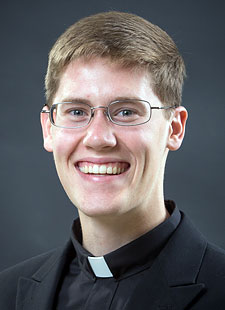Official Website of the
Catholic Diocese of Little Rock
Letters from Seminary: Hartnedy
Lesson from St. John: Power of the cross found in love
Published: April 9, 2022
By John Paul Hartnedy
Diocesan Seminarian
For more than 2,000 years, a Roman tool for torture and execution has been a Christian’s most prized possession. The cross adorns every Christian church, likely without exception. The crucified Christ hangs on classroom walls, hospital rooms and living rooms alike as a prominent standard of our faith in both public and private settings.
 The cross is the central symbol of our faith in Jesus and the salvation he won for us. It calls us to conversion at all times, but especially during Lent. This Lent, I’ve been reading “The Science of the Cross” by a modern Carmelite saint, Teresa Benedicta of the Cross, also known as Edith Stein.
The cross is the central symbol of our faith in Jesus and the salvation he won for us. It calls us to conversion at all times, but especially during Lent. This Lent, I’ve been reading “The Science of the Cross” by a modern Carmelite saint, Teresa Benedicta of the Cross, also known as Edith Stein.
While it may sound like a dry textbook or a cumbersome manual, this is a penetrating meditation on St. John of the Cross’ experience of the cross in his life and theology. It reveals how the saint learned to embrace the crosses that came his way with the joy and strength that flowed from his relationship with God.
The cross is an invitation to allow Christ to live his paschal mystery more deeply within us, not in some abstract way, but concretely. In freedom, we can change our habits, decide to forgive, give of ourselves in love and practice virtue.
Assured of God’s love for him, he responded with his whole heart in love and service. With Paul, he could “boast in the cross” (Galatians 6:14), not in a celebration of suffering and death, but in gratitude for how much God loved him and enabled him to love.
Not only has this book been fruitful for my Lenten journey so far, but it also has guided my final preparations for diaconate ordination. Through the lens of the cross, I have looked back, reviewing the last seven years of seminary formation. In prayer, study and ministry, the Lord has been present, inviting me to give myself more fully in love.
I’ve also looked ahead. In six weeks, I will stand before Bishop Taylor and the gathered community and commit my life to prayer and service. I will promise to love celibately and to imitate the example of Christ in how I live. Finally, I will kneel before him and promise respect and obedience to him and his successors.
Clearly, the cross is present here, from the beginning of ordained ministry. Yet, it is not a vocation without joy and fulfillment. Countless priests, deacons, religious men and women and married couples testify to the opposite. By embracing the various crosses in their vocations as they arise, they live fulfilled and at peace, even in times of turbulence. Just like St. John of the Cross, they know from experience that the meaning and power of the cross is found in love.
Through love, an efficient and cruel instrument of torture was transformed into the instrument of salvation. I, too, have found that when I surrender to God and love as I can amid suffering, the experience of the cross reorders my life, sustains me and leads me to new life. Afterall, Good Friday does not stand alone; it is complete in the joyful celebration of Easter Sunday.
The cross is an invitation to allow Christ to live his paschal mystery more deeply within us, not in some abstract way, but concretely. In freedom, we can change our habits, decide to forgive, give of ourselves in love and practice virtue. Whenever we are reminded of this central sign of our faith, there is always the opportunity and grace needed to love.
John Paul Hartnedy, a member of St. Edward Church in Little Rock, is a diocesan seminarian attending Assumption Seminary in San Antonio, Texas. This article was originally published in Arkansas Catholic. Copyright Diocese of Little Rock. All rights reserved. This article may be copied or redistributed with acknowledgement and permission of the publisher.




